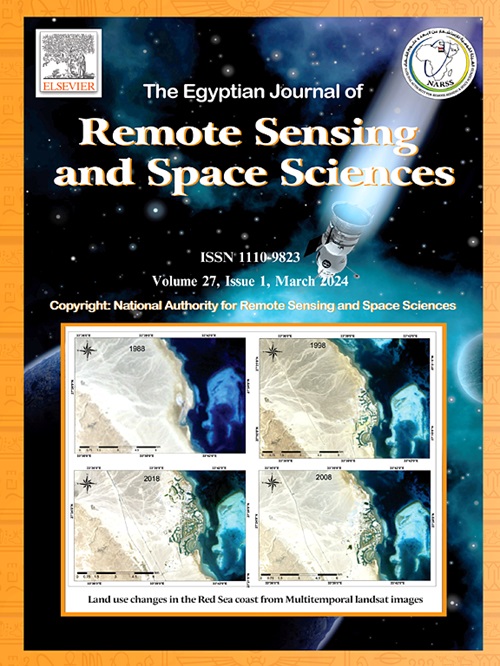Slope stability and disaster mechanisms in the Honghe Hani Terraces: a systematic review
IF 3.7
3区 地球科学
Q2 ENVIRONMENTAL SCIENCES
Egyptian Journal of Remote Sensing and Space Sciences
Pub Date : 2025-06-27
DOI:10.1016/j.ejrs.2025.06.003
引用次数: 0
Abstract
Slope stability and disaster mechanisms are critical concerns for the Honghe Hani Terraces (HHT), a UNESCO World Heritage Site renowned for its unique agricultural and cultural heritage. This systematic review examines the factors influencing slope instability, the role of climatic conditions, and the impact of agricultural practices in the region. Using the PRISMA framework, 105 studies from 2000 to 2023 were analyzed, identifying key trends and research gaps through bibliometric and thematic analyses. The findings reveal that natural factors, such as rainfall intensity and soil properties, interact with anthropogenic factors, including land use changes and traditional farming practices, to significantly influence slope stability. While traditional agricultural techniques like terracing can enhance soil conservation, improper management and recent land use changes, such as deforestation and urbanization, have intensified instability. Numerical simulations highlight the complex interplay between rainfall, irrigation, and slope dynamics, emphasizing the need for integrated management strategies. The review underscores the importance of combining traditional knowledge with modern technologies, such as remote sensing and GIS, to develop sustainable land management practices and early warning systems. Community involvement and capacity-building are also essential for effective mitigation. Despite limitations, such as methodological variability and data inconsistencies, this review provides a comprehensive understanding of slope stability in the HHT and proposes future research directions to enhance disaster resilience and preserve this unique cultural landscape.
红河哈尼阶地边坡稳定性与灾害机制系统综述
红河哈尼梯田以其独特的农业和文化遗产而闻名于世,其边坡稳定性和灾害机制是红河哈尼梯田的关键问题。本系统综述考察了影响边坡不稳定的因素、气候条件的作用以及该地区农业实践的影响。利用PRISMA框架,对2000年至2023年的105项研究进行了分析,通过文献计量学和专题分析确定了关键趋势和研究差距。研究结果表明,降雨强度和土壤性质等自然因素与土地利用变化和传统耕作方式等人为因素相互作用,对边坡稳定性产生显著影响。虽然梯田等传统农业技术可以加强土壤保持,但管理不当和最近的土地利用变化,如森林砍伐和城市化,加剧了不稳定。数值模拟强调了降雨、灌溉和边坡动态之间复杂的相互作用,强调了综合管理策略的必要性。该审查强调了将传统知识与遥感和地理信息系统等现代技术结合起来以发展可持续土地管理做法和早期预警系统的重要性。社区参与和能力建设对于有效缓解也是必不可少的。尽管存在方法差异和数据不一致等局限性,但本文提供了对HHT边坡稳定性的全面理解,并提出了未来的研究方向,以增强灾害恢复能力并保护这一独特的文化景观。
本文章由计算机程序翻译,如有差异,请以英文原文为准。
求助全文
约1分钟内获得全文
求助全文
来源期刊
CiteScore
8.10
自引率
0.00%
发文量
85
审稿时长
48 weeks
期刊介绍:
The Egyptian Journal of Remote Sensing and Space Sciences (EJRS) encompasses a comprehensive range of topics within Remote Sensing, Geographic Information Systems (GIS), planetary geology, and space technology development, including theories, applications, and modeling. EJRS aims to disseminate high-quality, peer-reviewed research focusing on the advancement of remote sensing and GIS technologies and their practical applications for effective planning, sustainable development, and environmental resource conservation. The journal particularly welcomes innovative papers with broad scientific appeal.

 求助内容:
求助内容: 应助结果提醒方式:
应助结果提醒方式:


